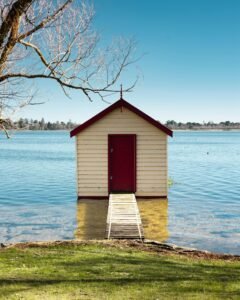The Ultimate Guide to Building Your Shed

Introduction
Embarking on building your shed can be both exhilarating and daunting. It’s a venture that promises additional storage space, a sense of accomplishment, and the opportunity to tailor a structure to your exact needs. Whether you’re envisioning a simple storage shed, a backyard workshop, or a cozy retreat, the prospect of constructing it from scratch opens up a world of possibilities. Effectively creating a shed requires careful preparation, attention to detail, and a comprehensive understanding of the building procedures. This thorough manual will lead you through every stage of constructing your shed, offering expert guidance, handy suggestions, and insightful perspectives to assist you in realizing your project.
Quick Tips
Before we dive into the intricacies of shed construction, let’s start with some quick tips to set you on the right path:
- Start with a Clear Vision: Define the purpose of your shed and visualize how you’ll use the space. Understanding your needs and priorities will inform every aspect of the design and construction process.
- Check Local Regulations: Before you break ground, familiarize yourself with local building codes and regulations. Obtaining the necessary permits and approvals upfront will save you time and headaches later.
- Invest in Quality Materials: Choose durable materials that endure different weather conditions and remain firm over time. Although it might be pricier upfront, investing in high-quality materials will ultimately result in a resilient and durable shed that lasts for years.
- Prioritize Safety: Always prioritize safety when working on your shed. Wear appropriate safety gear, follow manufacturer instructions for tools and equipment, and take necessary precautions to prevent accidents and injuries.
- Take Your Time: Constructing a shed is a substantial project that demands thorough planning and precise implementation. Take your time with any step of the process. Take your time to ensure each phase is completed correctly for a structurally sound and aesthetically pleasing result.
Now that you have these essential tips let’s delve into the detailed process of building your shed.
Planning Your Shed
Before you pick up a hammer or saw, laying the groundwork for your shed project is essential. Planning is the foundation for the success of your construction project.
Determining the Purpose and Size
 The first step in planning your shed is determining its primary purpose and the size you’ll need. Are you building a simple storage shed for garden tools and equipment? Or do you envision a larger structure for woodworking or hobby projects? Consider your current and future storage needs to ensure that your shed will be adequately sized for its intended use.
The first step in planning your shed is determining its primary purpose and the size you’ll need. Are you building a simple storage shed for garden tools and equipment? Or do you envision a larger structure for woodworking or hobby projects? Consider your current and future storage needs to ensure that your shed will be adequately sized for its intended use.
Selecting the Location
Choosing the right location for your shed is crucial for its functionality and aesthetics. Consider elements like ease of access, amount of sunlight exposure, and distance from other buildings on your land. Avoid low-lying areas prone to flooding, and ensure that your shed is positioned in a way that complements your landscape and doesn’t obstruct views or pathways.
Checking Local Building Codes and Regulations
Before you start construction, you must check with your local building department to understand any zoning restrictions, setback requirements, or building codes that may apply to your shed project. Failure to comply with these regulations could result in fines or the need to tear down and rebuild your shed, so obtaining any necessary permits and approvals is crucial before you begin.
Budgeting for Materials and Tools
Once you have a clear vision of your shed’s design and location, it’s time to create a budget for your project. Consider the cost of materials, tools, permits, and any professional assistance you may need. Be sure to factor in unexpected expenses and contingency funds to cover any unforeseen challenges during construction.
Designing Your Shed
With the planning phase complete, it’s time to bring your shed to life on paper. Planning your shed’s layout, style, and features empowers you to envision the end result and make well-informed choices regarding its design.
Choosing the Right Shed Style
Sheds come in various styles, from classic gable-roofed structures to modern lean-tos and everything in between. When choosing a shed design, you must consider both your taste and the architectural aesthetic of your residence and its natural surroundings.
Sketching Out Your Shed Design
Once you’ve settled on a style, it’s time to create a detailed sketch of your shed design. Use graph paper or design software to map out your shed’s dimensions, layout, and features, including windows, doors, and interior storage options. This will serve as a blueprint for construction and help you visualize the finished product.
Deciding on Materials
The choice of materials will play a significant role in your shed’s durability, aesthetics, and maintenance requirements. Standard options include wood, metal, vinyl, and resin, each with advantages and considerations. When selecting materials for your shed, consider cost, longevity, and compatibility with your desired design aesthetic.
Considering Additional Features
In addition to the basic structure, consider any additional features or amenities you’d like to incorporate into your shed design. These could include windows for natural light and ventilation, built-in shelving or workbenches for storage and organization, or decorative elements such as flower boxes or architectural details. These extra elements will improve the functionality and convenience of your shed while also enabling you to customize it according to your preferences and requirements.
Gathering Materials and Tools
Once you’ve settled on the design for your shed, the next step is to gather all the materials and tools required for building it. Everything you need will streamline the building process and ensure that construction proceeds smoothly.
Creating a Comprehensive Materials List
Compile a detailed list of construction materials, including lumber, roofing materials, siding, fasteners, and hardware. Take accurate measurements of your shed design to ensure you purchase the correct quantities of each material and avoid waste. When choosing materials for your shed, it’s essential to consider various factors, like how long-lasting they are, their ability to withstand weather conditions, and how well they match the look you aim for.
Tools Needed for Construction
Gather the essential tools and equipment for building your shed, including a hammer, saw, level, drill, tape measure, and safety gear. Depending on your shed design and construction methods, you may also need specialized tools such as a circular saw, framing nailer, or power drill. If you don’t already own these tools, consider borrowing or renting them to save money on upfront costs.
Tips for Sourcing Affordable Materials
Shop for the best building materials deals, comparing prices at local hardware stores, lumberyards, and online retailers. Look for sales, discounts, and bulk pricing to stretch your budget further and save money on construction costs. Consider purchasing imperfect or discounted materials, such as lumber with minor cosmetic defects or discontinued siding colors, to reduce expenses without sacrificing quality.
Preparing the Site
Before commencing construction, preparing for the site where your shed will be situated is essential. Site preparation is necessary to ensure your shed’s stable foundation and long-term durability.
Clearing and Leveling the Ground
Start by clearing the site of any vegetation, rocks, or debris that could interfere with construction. Use a shovel, rake, or grading equipment to level the ground and create a flat surface for your shed. Removing any organic material, such as tree roots or stumps, could decompose over time and cause the ground.
Creating a Solid Foundation
The foundation is the backbone of your shed, providing stability and support for the structure above.
Various factors, including soil quality, adherence to local construction regulations, and individual preferences, determine the selection of foundation type.
- Concrete Slab: A concrete slab foundation is durable and long-lasting, providing a solid base for your shed. To create a concrete slab, you’ll need to excavate the site, pour and level the concrete, and allow it to cure before building on top of it.
- Gravel Pad: A gravel pad is a more affordable and DIY-friendly option for shed foundations. To prepare a solid foundation for your shed, begin by leveling the ground, then apply a layer of gravel evenly and compact it thoroughly. This will establish a stable surface for your shed. Gravel pads are ideal for sheds that don’t require a fully enclosed foundation.
- Pressure-Treated Skids: Pressure-treated skids are wooden beams that rest directly on the ground, supporting your shed’s floor framing. They’re a cost-effective option for sheds with minimal foundation requirements but may be susceptible to moisture damage over time.
Regardless of your foundation type, it’s essential to ensure it’s level, adequately drained, and securely anchored to prevent shifting or settling. Take the time to follow proper installation techniques and consult a professional if you need clarification on the best approach for your shed project.
Understanding Drainage Considerations
Proper drainage is critical for protecting your shed from water damage and prolonging its lifespan. Ensure that the site is graded to slope away from the shed, directing water away from the foundation and preventing pooling or runoff. Consider installing gutters and downspouts to channel rainwater away from the shed, and incorporate French drains or swales if necessary to manage excess moisture in the surrounding area.
By properly preparing the site for your shed, you’ll lay a solid foundation for a sturdy, long-lasting structure that will serve you well for years to come.
Building the Shed
 With the site prepared and materials in hand, it’s time to roll up your sleeves and start building your shed. Your planning and preparation will pay off as you see your vision take shape.
With the site prepared and materials in hand, it’s time to roll up your sleeves and start building your shed. Your planning and preparation will pay off as you see your vision take shape.
Constructing the Frame
The frame is the skeleton of your shed, providing structural support for the walls, roof, and doors. Begin constructing the floor frame using pressure-treated lumber for durability and rot resistance. Secure the frame to the foundation using anchor bolts or screws, ensuring that it’s level and square before proceeding.
Afterward, construct the wall frames employing conventional framing methods, ensuring that studs are evenly spaced and incorporating openings for windows and doors as outlined in your design blueprints. Once the wall frames are complete, stand them upright and secure them to the floor frame using nails or screws. Check for plumb and alignment to ensure a straight and square structure.
It’s time to tackle the roof framing with the walls in place. Depending on your shed design, this may involve constructing trusses or rafters and installing them at the appropriate pitch and spacing. Once the roof framing is complete, add sheathing to provide a solid base for the roofing material, whether shingles, metal panels, or another option.
Installing Walls, Roof, and Doors
With the frame constructed, it’s time to enclose your shed with walls, a roof, and doors. Install exterior siding or cladding, ensuring it’s properly aligned and secured to the frame to protect it from the elements. Add windows for natural light and ventilation, positioning them according to your design plans and sealing them to prevent leaks.
Next, install the roof covering, whether asphalt shingles, metal roofing panels, or another material. Follow manufacturer instructions for proper installation, overlapping seams, and fastening securely to prevent wind damage and water infiltration.
Finally, hang the doors to complete the enclosure, ensuring they open and close smoothly and latch securely. Add locks or security features to protect your shed’s contents and deter unauthorized access.
Adding Windows and Ventilation
Adequate airflow is crucial for ensuring a pleasant and healthful atmosphere within your shed, especially if you intend to store tools, machinery, or any items prone to damage from dampness or mold formation. Install windows to provide natural light and airflow, positioning them strategically to maximize ventilation while minimizing heat gain and loss.
In addition to windows, consider incorporating vents or louvers into your shed’s design to facilitate airflow and prevent condensation buildup. Depending on your shed’s configuration and ventilation needs, these can be installed in the walls, roof, or gables. Be sure to choose vents that are compatible with your shed’s construction materials and provide adequate airflow for the size of the structure.
Insulating and Weatherproofing
Depending on your climate and intended use, you may insulate your shed to regulate temperature and improve energy efficiency. Common insulation materials include fiberglass batts, foam boards, or spray foam, each with advantages and considerations. Install insulation between wall studs, roof rafters, and floor joists, sealing gaps and air leaks to maximize efficiency.
Aside from insulating, it’s crucial to weatherproof your shed to shield it from various weather conditions and extend its durability over time. This includes sealing gaps and cracks with caulk or weatherstripping, applying a waterproof membrane or sealant to the exterior surfaces, and ensuring that doors and windows are properly sealed and weatherproofed. By taking these steps, you’ll create a comfortable, energy-efficient, and durable space that will stand up to the rigors of the elements for years to come.
Finishing Touches
 Now that the framework of your shed is finished, it’s the perfect moment to incorporate those final details that will genuinely personalize it to your liking. This is where you can let your creativity shine and add personal touches to enhance its functionality and aesthetics.
Now that the framework of your shed is finished, it’s the perfect moment to incorporate those final details that will genuinely personalize it to your liking. This is where you can let your creativity shine and add personal touches to enhance its functionality and aesthetics.
Painting or Staining the Shed
Adding a layer of paint or stain to the outside of your shed improves its look and shields it from moisture, sunlight, and other outdoor elements. Choose a high-quality exterior paint or stain for your shed’s construction materials and climate conditions. Consider coordinating the color scheme with your home or landscape to create a cohesive and visually appealing look.
Before applying paint or stain, it’s essential to adequately prepare the surface by thoroughly cleaning it and addressing any existing damage or flaws. Use a primer to seal bare wood or metal surfaces, improve adhesion, and apply multiple coats of paint or stain for maximum durability and coverage. Remember to paint or stain the interior of your shed as well, if desired, to create a cohesive and finished appearance.
Adding Trim and Decorative Elements
Trim and decorative elements are the finishing touches that give your shed character and charm. Install trim around windows, doors, and corners to provide a polished and professional look, choosing materials and styles that complement your shed’s design aesthetic. Add architectural details such as shutters, flower boxes, or gable accents to enhance visual interest and curb appeal.
In addition to trim, you can personalize your shed with decorative elements such as signage, outdoor lighting, or landscaping features. Plant flowers or shrubs around the perimeter, hang a decorative welcome sign on the door or install outdoor lighting fixtures to illuminate the nighttime space. These subtle details can transform your shed from a primary storage area into a charming and welcoming outdoor sanctuary.
Installing Shelving and Storage Solutions
 Maximize the functionality of your shed by installing shelving and storage solutions to keep your tools, equipment, and supplies organized and accessible. Customizing the interior layout to suit your specific needs will enhance the usability and efficiency of your shed.
Maximize the functionality of your shed by installing shelving and storage solutions to keep your tools, equipment, and supplies organized and accessible. Customizing the interior layout to suit your specific needs will enhance the usability and efficiency of your shed.
Evaluate Your Storage Needs: Before installing shelves or solutions, assess your storage needs and prioritize items based on frequency of use and accessibility. Consider the items you’ll store in your shed, such as gardening tools, lawn equipment, or seasonal decorations, and plan your storage layout accordingly.
Maximize Vertical Space: Make the most of your shed’s vertical space by installing shelves, cabinets, or wall-mounted organizers. Adaptable shelving enables you to tailor the arrangement to fit objects of different sizes and shapes, whereas pegboards or slatwall systems offer flexible storage solutions for tools and accessories.
Utilize Overhead Storage: To use overhead space, use overhead racks or loft storage platforms. These can be used to store bulky or seasonal items that are used less frequently, keeping them out of the way and freeing up floor space for more accessible storage.
Invest in Quality Storage Solutions: Choose durable, weather-resistant storage solutions that can withstand the rigors of outdoor use. Look for powder-coated steel, heavy-duty plastic, or pressure-treated wood designed to withstand moisture exposure, UV rays, and temperature fluctuations.
Organize and Label: Keep your shed organized and clutter-free by grouping similar items and labeling shelves or bins for easy identification. This makes it easier to find what you need when you need it and helps maintain a tidy and efficient workspace.
Consider Specialty Storage: Depending on your hobbies and interests, you may want to incorporate specialty storage solutions into your shed design. For example, if you’re an avid gardener, you might install a potting bench or tool rack for storing gardening supplies. If you enjoy woodworking, you might add a workbench or tool wall for storing and organizing woodworking tools and materials.
Maintaining Your Shed
After finishing the construction of your shed and setting it up with all necessary equipment, it’s crucial to establish a consistent maintenance schedule to keep it in top condition for the long term. Proper maintenance will help protect your investment and prolong the life of your shed, allowing you to enjoy its benefits for many seasons.
Schedule Regular Inspections: Conduct periodic inspections of your shed to check for signs of damage, wear, or deterioration. Evaluate the base for any indications of fissures, inspect the rooftop for displaced or missing shingles, examine doors and windows for potential sagging, and remain vigilant for signs of pests or water-related issues. Please address any issues promptly to prevent them from escalating into more significant problems.
Perform Routine Maintenance Tasks: Schedule regular maintenance tasks to maintain your shed well. These may include cleaning gutters and downspouts, lubricating door hinges and locks, sealing gaps and cracks, and treating wood surfaces with a protective finish. Taking proactive measures and promptly dealing with maintenance tasks can stop minor issues from escalating into significant problems.
Protect Against Weather Damage: Protect your shed from the elements, especially during extreme weather. Make sure to fasten down any items that might become airborne in strong winds, remove snow and ice from the roof to prevent accumulation and potential structural harm, and verify that drainage systems are clear and operational to avoid water damage.
Address Pest Infestations: Look for signs of pests such as rodents, insects, or birds, which can damage your shed and its contents. Implement pest prevention measures such as sealing entry points, storing food and trash in sealed containers, and removing debris and vegetation around the shed to eliminate hiding places for pests.
Monitor Structural Integrity: Regularly check the structural integrity of your shed to ensure that it remains stable and secure. Inspect the foundation, walls, and roof for signs of shifting, settling, or damage, and make any necessary repairs or reinforcements to maintain structural integrity.
Prolong the Lifespan of Your Shed: Take proactive measures to prolong the lifespan of your shed and maximize its longevity. This includes choosing durable materials, applying protective finishes, and following best practices for construction and maintenance. By investing time and effort in proper upkeep, you can enjoy your shed for many years.
Related Table: Comparison of Shed Materials
| Material | Pros | Cons |
| Wood | Natural appearance, easy to customize | Requires regular maintenance |
| Metal | Durable, resistant to pests and decay | Susceptible to rust and corrosion |
| Vinyl | Low maintenance, moisture-resistant | Limited design options |
| Resin/Plastic | Lightweight, no maintenance required | Less durable, limited lifespan |
This table compares common shed materials, highlighting their advantages and disadvantages, to help you decide based on your needs and preferences.
Conclusion
Building your shed is a rewarding endeavor that offers practical and creative benefits. By following the comprehensive guide outlined above, you can confidently embark on your shed construction journey, knowing you have the knowledge and tools necessary to bring your vision to life. Remember to plan carefully, invest in quality materials, and prioritize safety throughout construction. By exercising patience, persistence, and careful attention to the details, you’ll eventually construct a robust and practical shed that not only complements your property but also fulfills your requirements for many years.
- Splash of Color: Creative Garden Shed Painting Ideas to Transform Your Backyard Oasis
- The Benefits and Types of Mobile Home Sheds
- History of the World in 100 Sheds
- Garden Shed Roof Repair Guide: Fix Leaks Quickly and Effectively
- Effective Garden Shed Pest Control Methods
- Designing Your Perfect Custom Garden Shed: A Comprehensive Guide
- Best Large Garden Sheds for Your Backyard: Discover the Perfect Storage Solution
- Transform Your Garden Shed: Creative Painting Ideas to Refresh Your Outdoor Space
- Top Small Garden Shed Ideas: Maximizing Your Garden Space
- The Pros and Cons of Metal Garden Sheds: Is It the Right Choice for You?

Leave a Reply